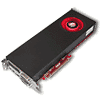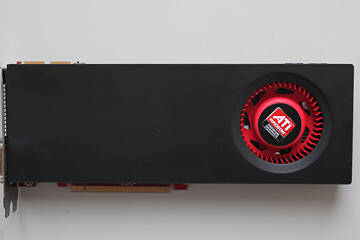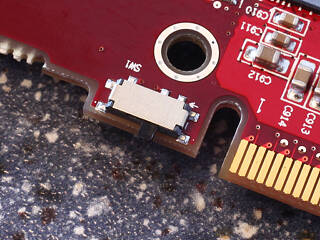 41
41
AMD Radeon HD 6950 1 GB Review
(41 Comments) »Introduction

AMD recently released their Radeon HD 6900 Series which delivers high-end 3D performance based around the new Cayman GPU. The new Series boasts improvements in power consumption while increasing performance over last generation. Most noteworthy, however, is the possibility to unlock a Radeon HD 6950 into a HD 6970 by a simple BIOS flash.
With the Radeon HD 6950 1 GB AMD introduces a new HD 6950 variant that is more cost effective than the 2 GB version. The price difference is about $40, just for 1 GB less memory, all other specs have remained the same. So the big question is: Will the reduced memory size affect performance?
| Radeon HD 6850 | Radeon HD 5850 | GeForce GTX 470 | Radeon HD 6870 | Radeon HD 5870 | Radeon HD 6950 | Radeon HD 6950 1 GB | GeForce GTX 570 | GeForce GTX 480 | Radeon HD 6970 | GeForce GTX 580 | |
| Shader units | 960 | 1440 | 448 | 1120 | 1600 | 1408 | 1408 | 480 | 480 | 1536 | 512 |
| ROPs | 32 | 32 | 40 | 32 | 32 | 32 | 32 | 40 | 48 | 32 | 48 |
| GPU | Barts | Cypress | GF100 | Barts | Cypress | Cayman | Cayman | GF110 | GF100 | Cayman | GF110 |
| Transistors | 1700M | 2154M | 3200M | 1700M | 2154M | 2640M | 2640M | 3000M | 3200M | 2640M | 3000M |
| Memory Size | 1024 MB | 1024 MB | 1280 MB | 1024 MB | 1024 MB | 2048 MB | 1024 MB | 1280 MB | 1536 MB | 2048 MB | 1536 MB |
| Memory Bus Width | 256 bit | 256 bit | 320 bit | 256 bit | 256 bit | 256 bit | 256 bit | 320 bit | 384 bit | 256 bit | 384 bit |
| Core Clock | 775 MHz | 725 MHz | 607 MHz | 900 MHz | 850 MHz | 800 MHz | 800 MHz | 732 MHz | 700 MHz | 880 MHz | 772 MHz |
| Memory Clock | 1000 MHz | 1000 MHz | 837 MHz | 1050 MHz | 1200 MHz | 1250 MHz | 1250 MHz | 950 MHz | 924 MHz | 1375 MHz | 1002 MHz |
| Price | $180 | $260 | $260 | $240 | $360 | $275 | $235 | $330 | $450 | $370 | $500 |
The Card
Visually AMD's HD 6950 1 GB looks exactly the same as the 2 GB variant, all changes were done under the hood.
The card requires two slots in your system.
The card has two DVI ports, one full size HDMI port and two mini-DisplayPort outputs. AMD's display output logic is clearly superior to what NVIDIA has to offer at this time. Vendors are free to combine six TMDS links into any output configuration they want (dual-link DVI consuming two links) - and use them all at the same time. AMD has also introduced DisplayPort 1.2 support with their new cards which allows the use of a DisplayPort hub to connect multiple monitors, or daisy chain them together.
An HDMI sound device is also included in the GPU. The HDMI interface is HDMI 1.4a compatible which includes Dolby TrueHD, DTS-HD, AC-3, DTS and up to 7.1 channel audio with 192 kHz / 24-bit output. The new revision also brings support for Blu-ray 3D movies which will become important later this year when we will see first Blu-ray 3D titles shipping.
You may combine up to four HD 69xx cards from any vendor in CrossFire.
Here are the front and the back of the card, high-res versions are also available (front, back). If you choose to use these images for voltmods etc, please include a link back to this site or let us post your article.
A Closer Look
AMD's heatsink uses a Vapor-Chamber Technology cooler with a large copper base. The thermal paste used is the same as on the HD 6990, a phase-change material that has the consistency of hard wax when cooled off but gets soft with higher temperatures.
The card has two 6-pin PCI-Express power connectors which are specified up to 225 W power delivery.
Like on the AMD HD 69xx reference designs, a BIOS switch is present which lets you select between the original BIOS and a backup BIOS in case something goes wrong with a BIOS flash. Combined with the HD 6950 to HD 6970 modding potential this makes an unbeatable combo because it's almost impossible that you screw up enough to end up with a $250 paperweight.
The GDDR5 memory chips are made by Hynix, and carry the model number H5GQ2H24MFR-T2C. They are specified to run at 1250 MHz (5000 MHz GDDR5 effective).
AMD is using a new voltage controller on their 1 GB card. While the HD 6950 / 6970 2 GB uses a Volterra VT1556, the 1 GB version uses a VT1586. Unfortunately this controller is not supported in any OC software - yet.
AMD's Cayman graphics processor is made on a 40 nm process at TSMC Taiwan. It uses approximately 2.64 billion transistors on a die area of 389 mm².
Our Patreon Silver Supporters can read articles in single-page format.
Jul 16th, 2025 03:11 CDT
change timezone
Latest GPU Drivers
New Forum Posts
- Choosing the right motherboard (12)
- Adding distilled water to ups batteries really work ? (18)
- Game Informer magazine is back! (15)
- What's your latest tech purchase? (24281)
- [GPU-Z Test Build] New Kernel Driver, Everyone: Please Test (97)
- Best motherboards for XP gaming (157)
- 3D Printer Club (545)
- The Official Thermal Interface Material thread (1792)
- What is the latest game you finished or 100% (54)
- Post your Cinebench 2024 score (661)
Popular Reviews
- MSI GeForce RTX 5060 Gaming OC Review
- SilverStone SETA H2 Review
- Our Visit to the Hunter Super Computer
- Lexar NM1090 Pro 4 TB Review
- NVIDIA GeForce RTX 5050 8 GB Review
- Fractal Design Epoch RGB TG Review
- Sapphire Radeon RX 9060 XT Pulse OC 16 GB Review - An Excellent Choice
- AMD Ryzen 7 9800X3D Review - The Best Gaming Processor
- Upcoming Hardware Launches 2025 (Updated May 2025)
- Corsair FRAME 5000D RS Review
TPU on YouTube
Controversial News Posts
- Intel's Core Ultra 7 265K and 265KF CPUs Dip Below $250 (288)
- Some Intel Nova Lake CPUs Rumored to Challenge AMD's 3D V-Cache in Desktop Gaming (140)
- AMD Radeon RX 9070 XT Gains 9% Performance at 1440p with Latest Driver, Beats RTX 5070 Ti (131)
- NVIDIA Launches GeForce RTX 5050 for Desktops and Laptops, Starts at $249 (122)
- NVIDIA GeForce RTX 5080 SUPER Could Feature 24 GB Memory, Increased Power Limits (115)
- Microsoft Partners with AMD for Next-gen Xbox Hardware (105)
- Intel "Nova Lake‑S" Series: Seven SKUs, Up to 52 Cores and 150 W TDP (100)
- NVIDIA DLSS Transformer Cuts VRAM Usage by 20% (99)













